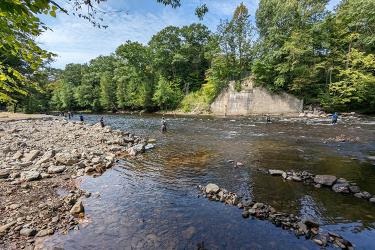Central Wisconsin is famous for its dairy farms, but it’s also home to the world’s largest aquaponic greenhouse, spanning over 13 acres. Superior Fresh is a family-run farm growing sustainable salmon and organic leafy greens for consumption across the Midwest and beyond.
Salmon is the most commonly eaten fish in the United States. In 2020, the United States imported over 637.1 million pounds (PDF, 28 pages) of salmon from abroad, the vast majority of which is farmed and transported by air freight. Superior Fresh is doing their part to reduce this seafood deficit. All their salmon is transported over land, with a smaller environmental footprint, providing Americans with a healthy source of domestic salmon.
Steve Summerfelt, lead scientist at Superior Fresh, is the mastermind behind raising salmon from egg to market. “Our salmon is fed organic-certified feed and is certified non-GMO by a Greener World, with a 'heartcheck healthy' certification from the American Heart Association," said Summerfelt. “Atlantic salmon is a superfood. High levels of OMEGA-3 fatty acids do incredible things for heart and brain health.”
At Superior Fresh, salmon are grown on land using freshwater tanks. It is a nearly closed system, with 99.9 percent of water treated and recycled within the facility. Fish waste is put to good use through a nutrient recycling process. Using a microbial biome that mineralizes the waste and releases its nutrients, the waste is repurposed and is used to fertilize the leafy greens. In addition to rigorous hygiene practices, a series of filters and disinfectants are employed to keep food clean.
The result of this closed system is that Superior Fresh produces nearly 1.5 million pounds of salmon and over 3 million pounds of leafy greens each year.
From Tide to Table
“We have great distributor partners that highlight Superior Fresh as a year-round farm to table supplier. They help us tell our story and connect with people through food, creating a high level of trust” said Summerfelt. “We love that people can enjoy our salmon and salads and have confidence that they are supporting a local family-owned farm.”
All Americans deserve access to healthy food, but not all communities have equal access. One way Superior Fresh is working to get organic greens into rural Midwestern communities is by supplying Kwik Trip gas stations. Superior Fresh leafy greens are sold in more than 800 Kwik Trips, reaching communities that might not have access to a larger grocery store.
In total, Superior Fresh sells their fish at more than 2,000 stores and supplies 100,000 healthy meals of salmon and salads to consumers each week.
Aquaculture Fun Fact
For every 1 pound of feed fed to salmon, Superior Fresh produces 3 to 4 pounds of human food—salmon and greens!
Recipe: Pan-Seared Salmon with Salmoriglio Sauce
Ingredients
Salmon
- 2 6-ounce Fresh Atlantic salmon portions, skin on or off
- Kosher salt
- Fresh coarsely ground pepper
Salmoriglio Sauce
- 10 ounces olive oil
- 10 ounces water
- 5 ounces lemon juice
- 8 tablespoons fresh oregano
- 2 cloves garlic, minced
- 1 teaspoons crushed red chili
- Coarse kosher salt to taste
Instructions
Salmoriglio Sauce
- Rinse and dry fresh oregano.
- Place garlic cloves, pinch of kosher salt, and chili in a mortar. Using a pestle mash ingredients into a paste.
- Combine olive oil and lemon juice in a bowl. Whisk in garlic, mash until mixed.
- Adjust seasoning with salt.
Salmon
- Pat salmon dry and generously season with salt and pepper.
- Place cold salmon in a non-stick pan over medium high heat.
- Cook until fat begins to render from skin, about 7 to 8 minutes.
- Turn the filet and cook an additional 3 to 4 minutes or until flesh is brown and internal temperature reaches 145 degrees.
- Remove from pan and allow to rest. Plate and drizzle with 2 tablespoons of sauce.
See how to cook this dish yourself with Superior Fresh’s video tutorial.
Sustainable Seafood from Tide to Table
The Tide to Table series profiles members of the aquaculture community who provide valuable jobs and increase access to fresh, sustainably sourced American seafood. Aquaculture is more than seafood production. It is about ecosystem stewardship, coastal communities, and economic opportunities.







